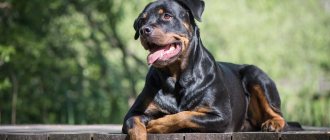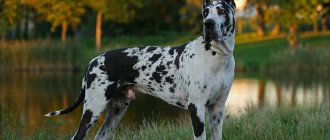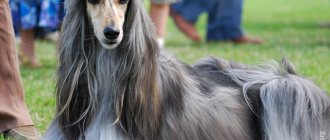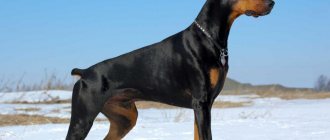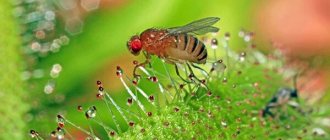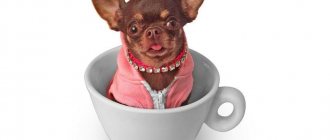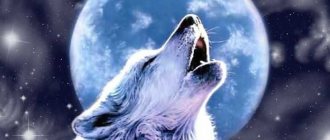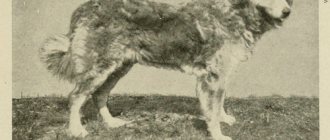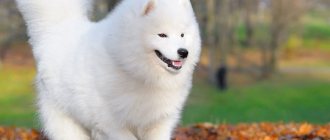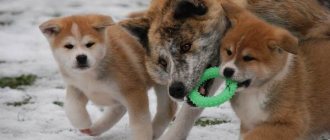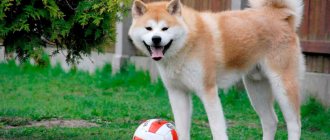American Bandoggy Mastiff
The breed is prohibited in the Russian Federation
A breed included in the list of prohibited breeds in the Russian Federation. It is impossible to purchase an American Bandog puppy legally in Russia. Nurseries specializing in this breed exist in Ukraine, Greece, England and the USA.
Bandog is the result of painstaking selection work. When the breed was just in its infancy, breeders were faced with the task of getting a large, aggressive animal that could take part in dog fights and win fights with pit bull terriers. As a result, Staffordshire Terriers and American Pit Bull Terriers were used to create a new breed. But the bandogs were inferior to their ancestors in dog fighting, although they turned out to be large, powerful and very aggressive.
Then the breeders decided to breed a Bandoggy Mastiff with a Neapolitan Mastino. The puppies turned out to be huge, loose and phlegmatic. Instead of calming down, breeders continued to experiment, using Tosa Inu, Cane Corso, Boerboel, etc. in their work.
Currently there are three breeding lines. The first and main are dogs obtained by crossing pit bull terriers and staffords. The second, less popular, animals whose pedigree includes Neapolitan mastiffs. And the third, practically not used, is bandogs with the blood of Tosa Inu, bullmastiffs, etc.
The American Bandog is a large and powerful dog. The weight of an adult male dog can reach 67 kg, and the height at the withers is 60 cm. As for the character of the animal, there are various rumors about Bandoggy Mastiffs. Foreign owners of representatives of this breed claim that their pets are just sweethearts. The websites of nurseries involved in breeding American Bandogs talk about the wonderful character of the breed. But if Bandoggy Mastiffs are so wonderful, then why are they banned in many countries?
American Bandogies are completely unsuitable for families with children. The ideal owner is a balanced, calm and firm man who is ready to give the dog a lot of time and effort. Representatives of the breed need education and socialization from a very tender age. Otherwise, a large dog with increased aggressiveness towards its own kind and people can turn into a killing machine.
By the way, modern American Bandoggy Mastiffs have a weak psyche, the animals are overly excitable. When a pet is in a state of extreme excitement, it is almost impossible to control it, because the bandog “turns off its head” at this moment.
Pitbull
The pit bull is a representative of the fighting breed, whose aggressiveness over the past many years they have tried to reduce at the genetic level. Pitbulls are tireless fighters with a steely fight. Outwardly, they are often compared to the American Staffordshire Terrier, but representatives of this breed have a so-called fighting spirit, excitement, which makes them especially dangerous to other dogs and people.
Excitement during a fight allows them to act at the edge of their physical capabilities. Courage and extreme courage best characterize these dogs. Pit bulls belong to the dominant type: if they are mishandled or gently raised, situations of aggressive behavior of the pet may arise.
Armenian gampr
Gampras are aggressive and stubborn
The second name of the breed is the Armenian Wolfhound. The animals are considered the national treasure of the country; breeding work has not affected the Gampras. Dogs can safely be called primitive (aboriginal).
The breed is one of the oldest; the first mentions of it appeared in the 1st century BC. A dog skull, identical to the heads of modern Gampras, was found in the 8th century BC, not far from Lake Sevan.
Until 1915, Armenian Gampras lived next to people, guarding their homes. When the Armenian genocide occurred, enemies began to destroy dogs with particular cruelty. Among the representatives of the breed, only those who had increased aggression and courage survived.
Today's gampras are very large, aggressive and powerful animals. It’s easy to imagine what an aboriginal dog looks like, whose height reaches 80 cm at the withers and weighs 75 kg.
The Armenian wolfhound is an independent animal. Dog owners claim that the animals are smart, can make independent decisions and do not need training. In addition, because of their disposition, they are extremely difficult to succumb to. If the gampr decided that there was an enemy in front of him, the latter would have a hard time. Representatives of the breed attack with lightning speed, and given their size, the victim’s path to salvation is cut off.
In the understanding of the Armenian wolfhound, any person can be an enemy if he poses a danger to the owner’s home or his flock. A random passer-by who suddenly raises his hand or screams loudly can be regarded as a danger. This is why Gumpers are considered one of the most evil dog breeds in the world, due to the dogs' excessive suspiciousness.
Anatolian karabash
Breed for protection
A breed with Molosser blood flowing through it. The Anatolian Karabash is considered the pride of Turkey; in its homeland, a representative of this breed is extremely difficult to buy. Turkish breeders will not sell a puppy to just anyone, and the babies are quite expensive.
Karabash is also called the Anatolian Shepherd. The dogs got their name in honor of the Anatolian plateau, where they were bred. Fifteen to twenty years ago, the name “Anatolian Karabakh” was found in books on dog breeding, but now it is not used.
Large and vicious dogs are completely unsuitable for apartment living. In their homeland, Karabashi guard the owner's herds and houses, and the breed was bred for this purpose. The ideal option for a pet’s life would be a large house with a plot and an insulated enclosure.
The size of such a pet is impressive: males can reach 90 cm at the withers and 70 kg in weight. Bitches are somewhat smaller, not as massive, but more cunning and aggressive than males.
There is information that the Anatolian Karabash gets along well with people, and for children it can become a real nanny. This is complete nonsense, dogs are patient with children, but they were bred for a completely different purpose. And if the child gets too naughty, the kangal is able to put him in his place.
The Anatolian Shepherd is capable of putting not only an annoying child in its place, but also an adult, strong man. Moreover, the dog will do this quietly and quickly; karabashi are good because they are rather silent animals. If your pet barks, it means it's worth it.
Although the Karabash is considered one of the most vicious breeds, the animal will not show aggression towards people for no reason. The problem, as in the case of the Armenian Gumpr, is that these dogs are too independent and capable of making independent decisions. If the Anatolian Shepherd decides that someone is a danger to the owner and his property, he attacks instantly. And being a breed bred to protect the home and herd, the Karabash can be suspicious of any stranger.
Rottweiler
The working breed was bred in Germany and is an excellent guard, and according to dog handlers, Rottweilers love to work.
They are hardy and always full of strength. Of all the breeds presented, Rottweilers have a calm disposition and balanced behavior, but they can also show aggression and sometimes cruelty.
Mostly aggression is shown towards other dogs. Dog handlers note that, despite the calmness, the dog is very emotional, and discord in the family where the Rottweiler is kept can also cause aggressive behavior.
Bully kutta
One of the most dangerous breeds in the world
The dog has several names: Pakistani Mastiff, Indian Mastiff, Sidney Mastiff.
This breed is not registered with the FCI, is prohibited in many countries and is among the TOP most aggressive in the world. India is considered the homeland of dogs; here animals were used for protection and for dog fighting. Later they were exported to Pakistan; local lovers of “bread and circuses” liked the huge, cruel dogs, suitable for bloody fights.
When India became a British colony, changes began to occur to the local mastiffs. The fact is that the British brought their dogs - mastiffs and bull terriers - to the territory of the conquered country. Selection work immediately began to develop a new breed, the ancestors of which were British and Indian mastiffs, as well as bull terriers. The result of breeding work was the modern Bully Kutta.
It is impossible to buy a puppy on the territory of the Russian Federation; representatives of this breed are included in the list of prohibited animals in our country. And keeping an Indian mastiff in a standard apartment is absolutely impossible. The fact is that Bully Kutta are simply huge dogs, the minimum height at the withers is 75 cm, and weight is 70 kg. An adult male can grow up to 110 cm at the withers and weigh 90 kg.
In addition to its frightening dimensions, no one has canceled the formidable disposition of the animal. It is hardly possible to walk with such a dog along a busy city street. Indian mastiffs have an extremely negative attitude towards the fuss around them, and they regard the people around them as a potential threat to the owner. The most interesting thing is that Bully Kutta and other animals are treated as enemies to be destroyed.
The danger of representatives of the breed lies in the regular testing of the owner for strength. If the Indian Mastiff senses weakness on his part, problems cannot be avoided. A self-confident dog will simply stop obeying such an owner. Trying to influence a Bully Kutta with physical force will end very badly for such an owner.
An aggressive and large dog that has no authority is quite capable of becoming a killing machine. And the first person who gets in her way will be a careless owner and his family.
Dogo Canario
The Dogo Canario is a powerful fighting breed with a high degree of aggressiveness. Great Danes belong to the average phenotype, they are proportionally built and have a strong strong bone structure. The dog has enormous physical strength, so it poses a threat to both other four-legged animals and people, especially if the dog is not trained correctly.
Great Danes clearly define the boundaries of a protected area or environment. They love calm and strive for total control. Therefore, the invasion of strangers is perceived negatively by Canarian dogs and does not bode well for the trespasser.
Brazilian Fila
Fila are beautiful, but extremely aggressive
The Fila Brasileiro or Brazilian Mastiff, as this breed is also called, is extremely aggressive and is banned in many countries. The dog's homeland, as the name suggests, is Brazil. The ancestors of modern dogs are bloodhounds and English bulldogs and mastiffs.
As a result of crossing the listed breeds, the Brazilian mastiff appeared. A large, tough and vicious dog that poses a danger to others. Imagine a dog, 70-75 cm tall at the withers, and weighing 80 kg. Moreover, with a huge head, powerful body, strong jaws. The horror comes from one picture drawn by the imagination.
Fila Brasileiros can only be kept in their own home; representatives of the breed are completely unsuitable for living in an apartment. The problem is that the fila will protect its territory from the invasion of strangers. A dog considers everything that its paw steps on to be territory. An apartment, a staircase, an entrance, a street where a representative of the breed is walking.
If a Brazilian mastiff comes to the conclusion that there is a stranger on its territory, there will be trouble. The dog attacks sharply and quickly, and in a rage becomes simply uncontrollable. It is unlikely that ordinary passers-by will want to become victims of a huge dog who has decided that a public street is his personal territory.
Brindisian fighting dog
It is impossible to buy such a dog in many countries.
One of the most dangerous breeds in the world, distinguished by its viciousness. The animals were bred in Italy, in a small town, from which they got their name. According to the official data that can be found about this Brindisian dog, it has the blood of Cane Corso, pit bull terriers and Rottweilers. Also, there is information about the participation of Dogo Canarios in the creation of this breed.
The Brindisian Fighting Dog is banned in almost all countries of the world; there is no uniform standard regarding its appearance. Cynological associations refuse to register the breed.
Animals were bred for fighting at a time when such cruel entertainment was officially permitted. To this day, representatives of the breed are used for illegal dog fighting, puppies are purchased illegally, for a lot of money.
The Brindisian is a large dog with strong bones. The typical representative of the breed has enormous anger towards everything he sees. A person, a child, another animal - it doesn’t matter, these dogs will violently destroy anyone. Once a Brindisian goes on a rampage, it is impossible to stop him until the victim stops resisting. Killing is the goal of life for these dogs.
Now it’s clear why the Bridinsian fighting dog is completely unsuitable for living in a city apartment or for families with children and other pets. Representatives of the breed require a very calm and balanced owner, remembering the ability of his pet to attack even him. Unfortunately, Brindisians fall into the hands of completely different people who cultivate the desire to kill in dogs.
Bull Terrier
Bull Terriers are dangerous fighting dogs with a very extravagant character. Their mood changes at lightning speed depending on their lively temperament. It is important to socialize dogs as early as possible, since the fear of the street inherent in many puppies of this breed gives rise to aggression and activation of natural instincts.
Representatives of this breed are quite loyal to people, but they are not always friendly towards other four-legged brothers. They are characterized by a high degree of conflict towards their own kind. Moreover, they attack without any warning signs. Bull Terriers were bred exclusively as a fighting dog with low sensitivity to pain, steel jaws, a compact powerful body, fearlessness and ferocity when participating in specialized fights.
Kohati-gulter
The breed is used for dog fighting
The breed comes from Pakistan. It is especially popular in the city of Kohat, which is why it got its name.
Goulter is the ancestor of such a breed as the Gul-Dong. The latter is considered the most dangerous in the world; in Russia it is included in the list of prohibited ones. As for the Kohati Gultera, the animal never gained popularity outside its homeland. The breed is not registered by any cynological organizations.
The Pakistani fighter is very large and durable. Males grow up to 70 cm at the withers, maximum weight is 65 kg. Representatives of the breed are kept exclusively in private homes, used as guards and closely monitored to ensure that the dog does not end up outside the gate. If the hulter somehow manages to escape into the street, the people who get in his way will come to an end. This white dog is distinguished by its choleric character and wild anger. An enraged Kohachi attacks fiercely and quickly, without hesitation.
And a little thing can anger a dog with such a temperament. But those who were nearby at the wrong time will have to pay.
Major Mastiff (ka-de-bo)
Unusual exterior and aggressive disposition
A very ancient breed, once almost extinct, but restored by breeders. The birthplace of ca-de-bo is the island of Mallorca.
The name of the breed translates as “dog for bulls.” Ca-de-bos were used in bullfights until 1933. When the authorities banned bloody entertainment, the Major Mastiff began to lose its popularity. Over the next 20 years, the animals almost became extinct.
They started restoring the breed only in the 80s of the last century. With great difficulty, dogs of the Ca-de-Bastira breed were found, most similar in appearance to the Ca-de-Beau.
Breeders bred representatives of this breed with English bulldogs, resulting in the modern Ca-de-Beau.
The appearance of animals is specific. Large, stocky, with piercing eyes and strong jaws. Males can reach 60 cm at the withers and 40 kg in weight, females are slightly smaller.
As for the nature of the Ca-de-Beau, dogs are extremely inconvenient for city life. The problem is their excessive aggressiveness towards strangers. Representatives of the breed are equally vicious towards both adults and strangers. Also, Major Mastiffs do not like other animals.
It is recommended to keep the ca-de-bo in a spacious private house. Pets require early socialization and education, training under the guidance of a competent dog handler who knows the breed and regular physical activity.
Kumaon mastiff
A real monster in the form of a dog
The breed's homeland is India; the dogs were originally bred in the regions of Kumaon and were used as guard animals.
There are several versions of the origin of the breed. The first says that Kumaon Mastiffs are descendants of aboriginal Himalayan dogs crossed with local Indian ones. According to the second theory, the first Kumaon mastiffs were obtained in Cyprus as a result of mating of local dogs and Himalayan natives. By the way, the second name of Kumaon mastiffs is Cypro Kukur.
The breed is completely unpopular outside of India. And few people would dare to become the owner of a “killing machine.” Kumaon can rightly be called this, for the dogs are huge and extremely vicious. The height and weight of animals reaches 90 cm at the withers and 80 kg, respectively. And aggression and distrust of strangers is frightening.
If a representative of the breed is raised anyhow, forgetting about quality training and socialization, the Kumaon will begin to kill everyone and everything.
Sarabi
The Iranian Mastiff is distinguished by its indomitable anger
No, we are not talking about Simba’s mother from the cartoon “The Lion King”. Sarabi is a dog that is especially popular in northern Iran. The second name of this giant is the Iranian mastiff.
The exact origin of the animal is unknown due to its lack of distribution outside Iran. At least the breed is not registered with the FCI and other cynological associations. Most likely, Sarabis are primitive dogs that were not touched by the hand of breeders.
Representatives of the breed are very large. Height at the withers can reach 1 meter, and weight – 90 kg. The larger the Iranian mastiff, the higher it is valued in its homeland. Representatives of the breed differ not only in size, but also in their formidable character. Sarabis are difficult to train and are very stubborn and ferocious. Iranian mastiffs are ideal as guards living on the territory of a private house.
Sarabis do not get along well with children; the dogs are serious and require respectful treatment of their person. A person who decides to meet a representative of the breed will not be lucky. At best, he will get off with severe bites, and at worst, he will end up in a cemetery.
Caucasian Shepherd Dog
Caucasian Shepherd Dogs are only supportive of members of their own family. They perceive all other people with caution. There is no bloodthirstiness in this breed, but aggression is present; they are easily wound up and become uncontrollable when angry. Therefore, the owner requires not only a firm hand (in no case cruelty), but also experience in raising large dogs. The reaction of the “Caucasian” is lightning fast, he copes with his guard duties perfectly. This is also helped by the phenomenal sensitivity of the animal, which is able to distinguish the slightest rustle even in sleep. The dog’s dimensions also play an important role: weight up to 75 kg and height up to 75 cm.
Caucasian Shepherd Dogs tolerate cold relatively easily, so they feel great in an enclosure and kennel.
“Caucasians” are infinitely devoted to their family, they are able to put up with even small animals, and among dogs they only get along calmly with decorative breeds. A larger pet is perceived as a rival, and reprisals will not be long in coming. The dog will not become a nanny for children, but it may well participate in their games.
Oddly enough, there is still no effective method of training Caucasian Shepherds. Even a course of OKD does not give lasting results.
